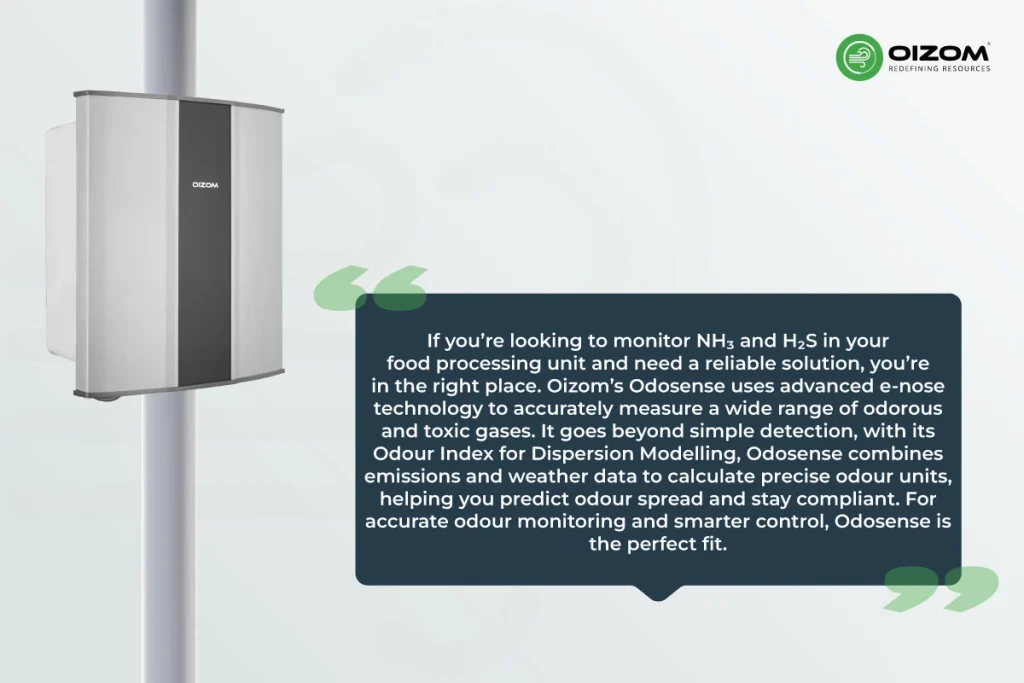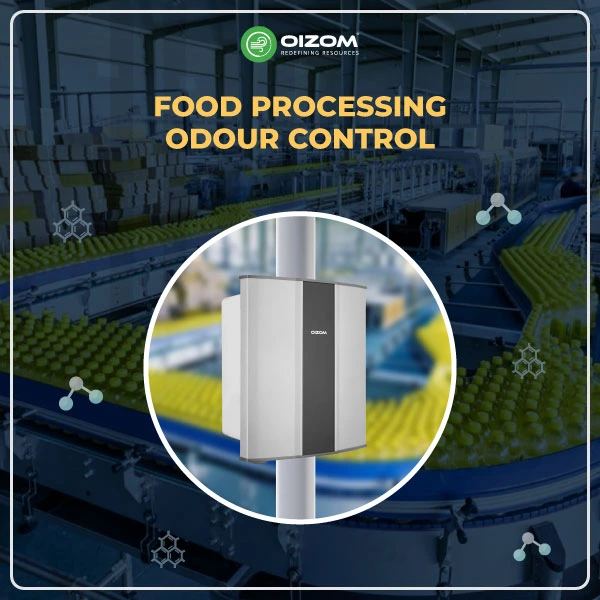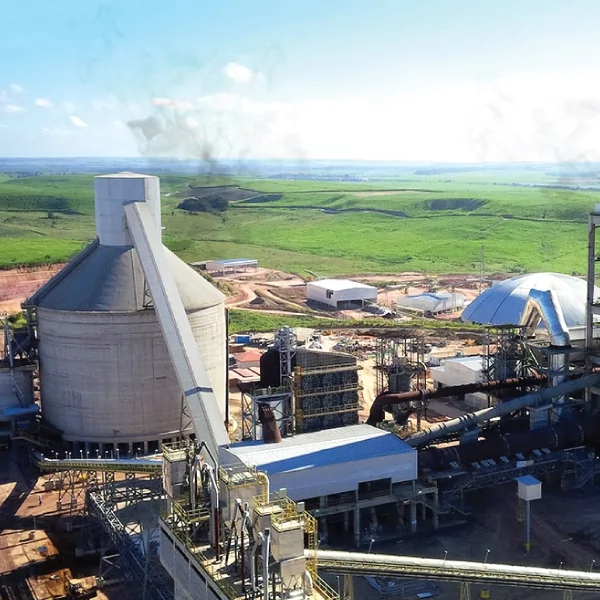Summary
In food processing, managing odour isn’t just about improving the workplace experience. It’s critical for regulatory compliance, public health, and community relations. This blog dives into where odours come from during processing steps like raw material handling, food processing, fermentation, and wastewater treatment.
We break down the key emissions involved, like VOCs, ammonia, and sulfur compounds, and why addressing them matters under evolving global standards. You’ll find practical insights into effective odour control technologies, from biofilters and chemical scrubbers to real-time ambient monitoring systems like Oizom’s Odosense.
Beyond just listing solutions, we also explore how combining smart monitoring with source-level controls helps industries stay ahead of complaints and regulations. Plus, we look at what’s next, how AI, IoT, and predictive models are shaping the future of odour management.
Simply put, odour control today is about building more responsible, future-ready operations. If you work in food processing, this guide helps you rethink odour not as a nuisance but as an opportunity for operational excellence.
Food Processing Odour Control
Odour might seem like a minor by-product in food processing, but in reality, it’s a significant environmental and operational challenge. Whether you’re handling meat, dairy, or fermentation-based production, releasing volatile organic compounds (VOCs) and process-specific emissions can trigger regulatory scrutiny, community complaints, and even operational downtime. Did you know this? In 2023 alone, over 2,000 food processing plants globally faced community complaints related to odour emissions, leading to lawsuits, shutdowns, and millions in lost revenue. Odour isn’t just about nuisance anymore; it’s a business risk you can’t ignore.
For industry professionals, odour control isn’t just about masking smells. It’s about engineering reliable, data-backed solutions that align with compliance frameworks and sustainability goals. From advanced biofiltration and activated carbon systems to real-time ambient monitoring, the technologies available today offer precise control and predictive insights. With rising environmental concerns and stricter air quality regulations, leading companies are stepping up their game by investing in advanced odour control systems. The market is on a steady rise, expected to grow from $1.3 billion in 2025 to $2.1 billion by 2035, at a CAGR of 4.5%.
In this blog, we’ll break down the key sources of odour in food processing, explore the latest control technologies, and dive into how integrated systems, including continuous monitoring tools, can help plants stay compliant, efficient, and community-friendly.
If you’re a plant manager, environmental consultant, or air quality researcher looking for technical clarity on odour control in food facilities, you’re in the right place. Let’s explore how to turn odour from a nuisance into a controlled parameter of operational excellence.
Why Odour Control is Crucial in Food Processing?
In food processing, odour is more than just a smell; it’s a signal. Uncontrolled odours can indicate the release of volatile organic compounds (VOCs), ammonia, hydrogen sulfide, and other process emissions that may impact both air quality and regulatory compliance.
Controlling odour in industries isn’t just good practice, it’s essential. Strong or frequent odours can lead to health issues like headaches, dizziness, or trouble sleeping. In fact, odour pollution is one of the most common complaints from people living near industrial zones.
Food facilities handling meat, seafood, dairy, fermentation, or spices often generate strong odours as a by-product of raw material breakdown, heating, or microbial activity. Without proper control systems, these emissions can spread into surrounding communities, leading to complaints, reputational damage, and even legal action.
From a technical perspective, odour control helps in maintaining safe workplace conditions, reducing corrosion risks from acidic gases, and supporting compliance with environmental norms set by agencies like the CPCB, EPA, or EEA. Many countries now require food industries to monitor and report odour levels in OUE/m³ (Odour Units per cubic meter), pushing companies to invest in reliable mitigation strategies.
Technologies such as biofilters, activated carbon scrubbers, chemical oxidizers, and real-time odour monitoring systems are increasingly being adopted to manage emissions with precision and efficiency. Simply put, odour control isn’t just about keeping things smelling fresh; it’s about safeguarding air quality, meeting regulations, and running a responsible, future-ready operation.
Odour Norms and Regulatory Agencies Overview
| Region | Agency / Standard | Odour Guideline |
|---|---|---|
| EU | IPPC Directive, E-PRTR | Odour is considered a pollutant; continuous assessment and control are required |
| Germany | TA Luft, VDI 3880 | OUE/m³ thresholds based on zoning (residential vs industrial) |
| Netherlands | Geuremissienorm | Limits vary: typically 1–5 OUE/m³ depending on land use |
| UK | DEFRA | Odour is considered a statutory nuisance; BAT (Best Available Techniques) is required |
| USA | EPA (State-level) | No federal limit; states like Colorado and California define OUE/m³ standards |
| India | CPCB | No fixed odour threshold yet; odour control mandated under general air quality norms |
Impacts of Food Processing Odours
When we think about environmental problems, odours from food processing plants often don’t get much attention. But these smells are more than just a minor annoyance, they can signal bigger environmental and health issues. Most food processing odours are made up of volatile organic compounds (VOCs), which are gases released during the production, processing, and cooking of food.

Environmental Impact
- Air Pollution: Odours from food factories can mix with other pollutants and create harmful substances like ozone and fine particles. This can lower air quality and cause serious health issues like asthma, heart disease, and even cancer. Oizom’s smart monitoring solutions help industries track and control these emissions, making it easier to stay compliant and protect nearby communities.
- Greenhouse Gas Emissions: Some gases released, like methane from livestock processing, are powerful greenhouse gases. They trap heat in the atmosphere and make cities feel hotter, especially in urban areas.
- Water Pollution: When odorous gases settle into lakes, rivers, or groundwater, they can pollute drinking water and harm aquatic life.
- Damage to Plants: Some VOCs, like ozone, can damage leaves and plants, making it harder for them to grow and survive, especially in sensitive ecosystems.
Health Impact
Breathing in odours from food processing facilities can cause several health problems, such as:
- Breathing problems: Irritation of the lungs leading to asthma, bronchitis, and other respiratory issues.
- Heart issues: Increased risk of heart disease and strokes.
- Cancer: Some VOCs are proven to cause cancer with long-term exposure.
- Nervous system effects: Headaches, dizziness, nausea, fatigue, and other neurological symptoms. Were you aware of this? In 2024, 84% of nearly 1,700 air quality complaints in one U.S. state (Michigan) involved strong odours, with many callers explicitly citing headaches as a concern.
Social Impact on Nearby Communities
- Reduced Quality of Life: Strong odours can make living nearby unpleasant, lower property values, and affect how people use outdoor spaces.
- Mental Health: Long-term exposure to bad smells can cause stress, anxiety, depression, and worsen existing health problems like asthma.
Common Sources of Odours in Food Processing
Odours in food processing aren’t incidental; they’re the direct result of biological, chemical, and mechanical activities happening across the production chain. Knowing the source is critical to designing effective mitigation strategies.
- One of the biggest contributors is raw material handling and storage. Fresh meat, seafood, dairy, and produce can start to break down almost immediately after harvesting or slaughter. Microbial decomposition releases odorous gases like ammonia, hydrogen sulfide, amines, and short-chain fatty acids, especially under warm or anaerobic conditions.

- Thermal processes such as baking, roasting, frying, or smoking create odours through complex chemical reactions, mainly the Maillard reaction and lipid oxidation. These reactions release aldehydes, ketones, and VOCs, many of which have low odour thresholds, meaning even small amounts can be easily detected by humans.
- Fermentation processes in breweries, dairy plants, and pickling operations release ethanol, organic acids, sulfur compounds, and volatile esters. While essential for flavor development, in production environments, they often escape into the ambient air, creating strong odour zones.
- Cleaning and sanitation activities are another often-overlooked source. Using chlorinated cleaners, acids, or alkaline detergents can interact with residual organics on surfaces, generating pungent chemical odours, especially if not properly ventilated.
- Wastewater treatment units, common in large food facilities, emit odours during anaerobic digestion, sludge handling, or due to ineffective aeration. Hydrogen sulfide (H₂S), mercaptans, and methane are frequent offenders.
- Even packaging areas can contribute if volatile compounds are released during sealing, particularly with vacuum-packed or cooked products.
- Given the diversity of odour sources, a one-size-fits-all approach doesn’t work. Modern facilities increasingly rely on multi-stage control technologies, combining source capture systems, scrubbers, biofilters, and continuous ambient monitoring using real-time sensors to maintain compliance and protect community relations.
Proactive odour management not only safeguards the environment but also reinforces operational excellence in today’s competitive and regulation-driven market.
Common Sources of Odours in Food Processing
| Source | Key Odorous Compounds | Notes |
|---|---|---|
| Raw material handling | Ammonia, hydrogen sulfide, volatile amines | Protein degradation under anaerobic/warm conditions |
| Thermal processes (baking, roasting, frying) | Aldehydes, ketones, VOCs | Maillard reactions and lipid oxidation |
| Fermentation (breweries, dairy, pickling) (baking, roasting, frying) | Ethanol, organic acids, sulfur compounds | Low odour thresholds make even small emissions detectable |
| Cleaning and sanitation | Chlorinated organics, acidic/alkaline volatiles | Chemical odours from interaction with residual organics |
| Wastewater treatment | H₂S, mercaptans, methane | Anaerobic digestion, sludge handling without proper aeration |
| Packaging | Volatile compounds during sealing/cooking | Especially in vacuum-packed products |
Primary Sources of Odour in Food Processing Plants:
In food processing plants, odours mostly come from the way organic materials break down, change, or are handled. Here are some common sources:
- Meat and Rendering Plants: When animal parts break down, they can create strong, unpleasant smells.
- Cooking and Frying Areas: Cooking certain foods, like fish or heavily spiced dishes, can release strong odours.
- Fermentation Tanks: Making products like alcohol, vinegar, or dairy through fermentation can produce gases with a strong smell.
- Spice and Flavour Production: Handling large amounts of spices or making flavourings can cause intense aromas.
- Onion and Garlic Processing: Processing these in bulk is well-known for creating pungent odours.
- Roasting Operations and Breweries: Roasting coffee, nuts, or brewing beer can give off strong smells.
- Edible Oil Refineries: Processing oils, especially fish or certain seeds, can create noticeable odours.
- Grain and Feed Mills: Spoiled grains can lead to musty or mouldy smells.
- Dairy Processing: Some dairy products, like cheeses, can produce strong odours during production.
- Storage Silos: Poor ventilation can lead to mold growth, which causes bad smells.
Key Odour Control Strategies
Industrial odours can heavily impact nearby communities, making it essential for industries to manage them carefully. In sectors like food processing, controlling odour is not just about comfort. It’s about protecting health and the environment.
To tackle odour issues, industries use a mix of traditional methods and modern technologies, aiming to balance operational efficiency with environmental responsibility.
Understanding how these strategies work together is key to reducing the nuisance and risks associated with industrial odours. By implementing the right solutions, industries can operate responsibly while maintaining good relations with the communities around them.
- Source Capture and Containment: Installing localized extraction systems at odour hotspots (such as cooking areas, fermentation tanks, and wastewater pits) helps capture emissions at the source before they disperse. Proper ducting and negative air pressure systems further prevent leaks into the facility or surrounding environment.
- Biofiltration: Biofilters use a natural layer of microorganisms, typically placed over organic media like wood chips or compost, to break down odorous gases biologically. They are highly effective for treating large airflow volumes with moderate odour loads, especially gases like ammonia (NH₃) and hydrogen sulfide (H₂S)
- Activated Carbon Adsorption: Activated carbon filters physically adsorb odorous molecules onto their porous surface. This method is excellent for low-concentration but persistent odours, such as VOCs from thermal processing, offering up to 95%+ removal efficiency when properly maintained.
- Chemical Scrubbing (Wet or Dry Scrubbers): Chemical scrubbers neutralize odorous compounds by reacting them with specific chemical agents. For example, acidic scrubbers neutralize ammonia, while alkaline scrubbers target hydrogen sulfide. Multi-stage scrubbers are often used where complex odour mixtures exist.
- Real-Time Ambient Monitoring: Continuous odour monitoring using smart sensors, like Oizom’s Odosense, provides live data on odour intensity and trends. Integrated with meteorological data, it enables early detection of spikes, dispersion modeling, and helps optimize mitigation strategies in real time.
- Process Optimization and Operational Controls: Reducing odour generation at its source is always the most efficient solution. Measures include maintaining correct processing temperatures, upgrading exhaust systems, ensuring timely waste removal, and implementing hygienic design principles across production lines.
- Wastewater Treatment Odour Management: Proper aeration of wastewater lagoons, use of closed reactors, and covering sludge-handling systems minimize odours from anaerobic decomposition processes, a major contributor in food industries handling organic-rich waste.
- Odour Dispersion Modeling for Proactive Planning: Using odour dispersion models based on real-time emissions and meteorological conditions allows facilities to predict odour spread. This helps in strategic placement of scrubbers, ventilation outlets, and complaint prevention.
Conclusion
In food processing, odour control is not just about creating a better working environment. It’s a critical step toward ensuring regulatory compliance, protecting public health, and maintaining strong community relationships. With emissions often carrying complex mixtures of VOCs, ammonia, hydrogen sulfide, and other odorous compounds, industries can no longer rely on basic measures alone.
Effective odour management today demands a strategic combination of advanced filtration systems, source-level controls, and real-time air quality monitoring. Solutions like biofilters, chemical scrubbers, activated carbon adsorption, and intelligent platforms such as Oizom’s Odosense are redefining how facilities approach odour mitigation, with precision, efficiency, and accountability.
Looking ahead, the future of odour control in food processing will be shaped by AI-driven predictive models, IoT-based sensor networks, and stricter environmental standards. Facilities that embrace these innovations will not only stay compliant but also lead the industry toward more sustainable and responsible operations. By leveraging odour monitoring systems to improve air quality, companies can gain real-time insights and respond proactively to emission spikes.
Ultimately, investing in comprehensive odour control today means building a future where food processing plants can thrive without compromising the environment or the well-being of nearby communities. This shift also highlights the long-term benefits of implementing odour monitoring systems, from enhanced compliance to greater operational transparency.






